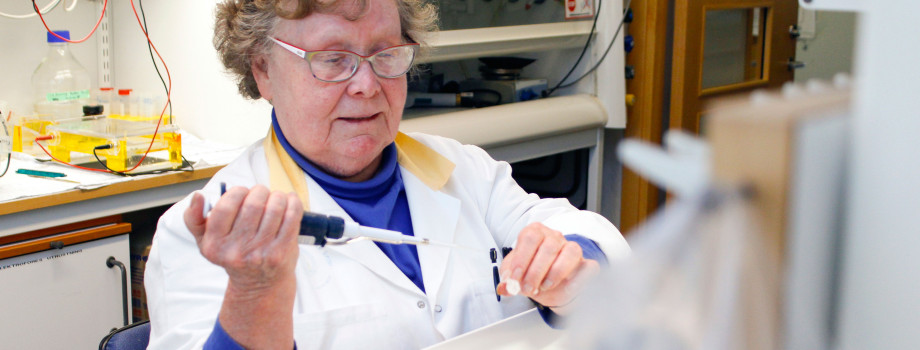NOBEL.
A shout of joy echoed through the hallways of Medicinareberget last Wednesday noon when the news came that Tomas Lindahl had been awarded the Nobel Prize in Chemistry. It was definitely the highpoint of the year for Monica Nilsson, who has worked at his side on many occasions.
“Thomas is an incredibly able researcher who taught me everything I know about proteins,” she smiles. “I wouldn’t be surprised if I was more thrilled by the announcement than he was.”

Were it not for Professor Lindahl, Ms. Olsson would certainly have retired at the age of 65. At 72, she remains a popular and esteemed laboratory assistant at Medicinareberget, now as a member of the team directed by Maria Falkenberg and Claes Gustafsson. She was Professor Lindahl’s right-hand lab assistant in 1978-1982 when he was affiliated with the University of Gothenburg.
“Those were highly rewarding and enjoyable years,” Ms. Olsson says. “Tomas has a dry, British-like sense of humor that always tickled my funny bone.”
She remembers picking up large quantities of neck sweetbread from a slaughterhouse in Varberg for laboratory experiments. Three kilograms were needed to ensure a sufficient supply of protein. With today’s modern methods, only a fraction of that amount is needed.

Ms. Olsson goes to get a printout of a 1980 scientific article about incorporation of a methyl base formed as the result of alkylated DNA into a special enzyme referred to as Ada. Published by the Journal of Biological Chemistry, the article was seminal when it comes to research about DNA repair. Ms. Olsson was the principal author. Professor Lindahl had entrusted such responsibilities to lab assistants before, but he went out of his way to make it clear that she was the best person for the job.
“He refuses to be impressed by a string of degrees or all the years you have spent in school,” Ms. Olsson says. “He respects and honors people who do their job well.”

Once Professor Lindahl had found his footing as research director for the Imperial Cancer Research Fund, he asked Ms. Olsson whether she would like to work with him for a year. This was 1987. The position came with attractive terms and she was immediately assigned a project to sink her teeth into.
“At first I felt like a nobody,” Ms. Olsson says. “The place was chock full of leading international researchers who held Tomas in extraordinary regard.”
Her closest colleague was an American postdoctoral researcher who had never worked with proteins in a laboratory before. Though he disagreed with her occasionally about how to set up an experiment, he acquiesced every time because he knew that Professor Lindahl trusted her implicitly.
“I knew that Tomas always had my back,” she says simply.

Researchers typically ask laboratory assistants to redo an experiment when they fail to obtain the expected results, but Professor Lindahl was of a different ilk.
“He would simply say, ‘Of course you know more about it than I do’ and leave it at that,” Ms. Olsson recalls.
Per Elias, Professor of Medical and Physiological Chemistry, chimes in that Professor Lindahl is a highly regarded researcher and more than deserving of the Nobel Prize.
“He has a knack for coordinating research projects and his visionary approach causes others to flock around him. Nobody is better than he is at identifying biological issues, reformulating them as
chemical challenges and finding a simple solution that reflects back on biological processes. Most of the work he has done is easy to follow and understand for that reason.”
Professor Lindahl has continued to collaborate with the University of Gothenburg over the years. He was made an Honorary Doctor of Medicine in 1991 and took part in an international panel of experts (RED10) that assessed research quality at the university in 2010. And Ms. Olsson is just as invaluable to him as ever. More than once he has asked her to come to England and help him determine whether the results reported in an article that he is reviewing are actually correct.
Read the article that Ms. Olsson and Professor Lindahl wrote for the Journal of Biological Chemistry in 1980: “Repair of Alkylated DNA in Escherichia Coli” http://www.jbc.org/content/255/22/10569.long
TEXT AND PHOTO: ELIN LINDSTRÖM CLAESSEN











